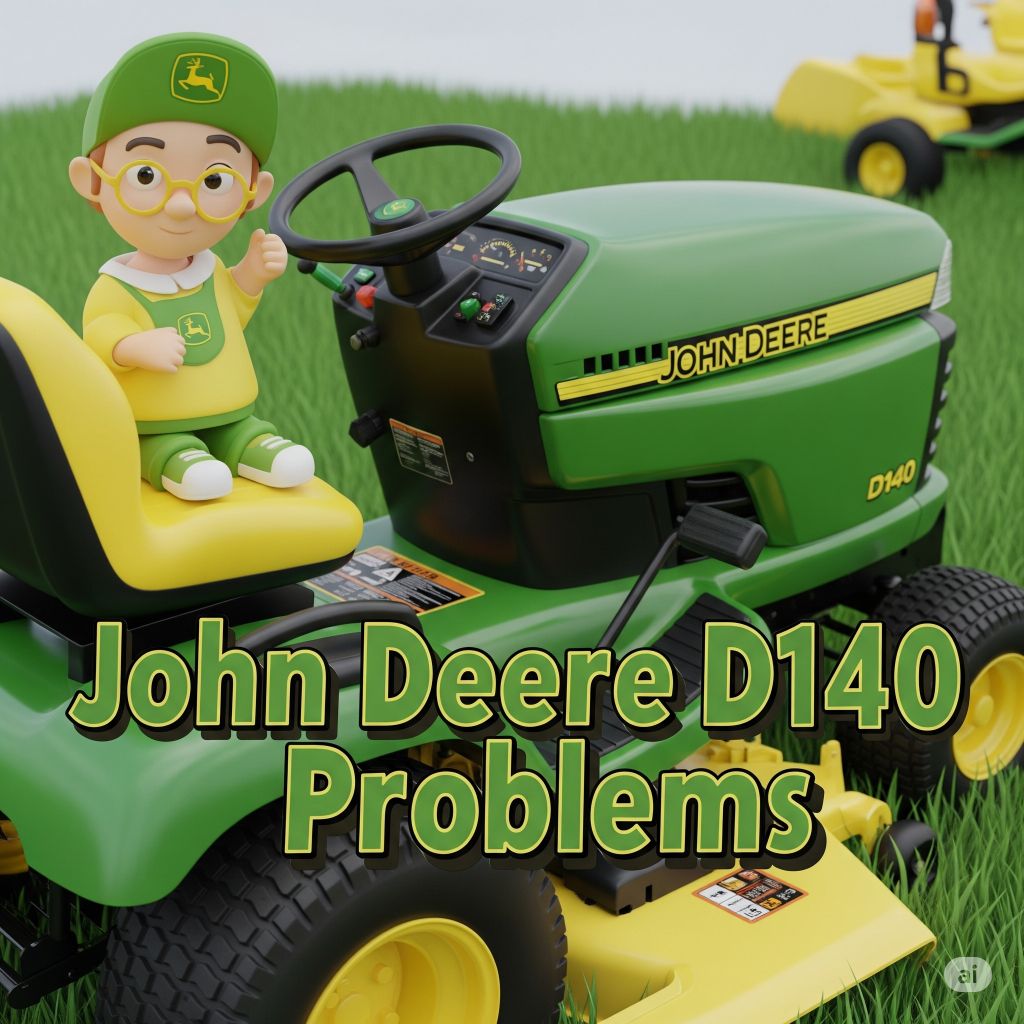
The John Deere D140 lawn tractor is known for its reliability and versatility, but it is not immune to occasional issues that can disrupt its performance. This article outlines common problems faced by D140 owners and practical solutions to address them effectively.
1. Engine Starting Problems
Symptoms:
- Engine does not start or takes a long time to crank.
- Engine stalls shortly after starting.
- Clicking noise when attempting to start.
Causes:
- Weak or dead battery.
- Clogged fuel lines or dirty fuel filter.
- Faulty starter motor or solenoid.
- Spark plug wear or misalignment.
Solutions:
- Battery Maintenance:
- Test the battery with a multimeter; fully charged batteries should read at least 12.6 volts.
- Clean corroded terminals and replace a failing battery.
- Fuel System Inspection:
- Replace dirty fuel filters and ensure the fuel tank is free of dirt, debris, or water contamination.
- Starter Motor and Solenoid:
- Check the starter motor for wear and test the solenoid. Replace any faulty components.
- Spark Plug Replacement:
- Inspect the spark plug for carbon buildup or damage. Replace it if it’s worn or improperly gapped.
2. Overheating Engine
Symptoms:
- Engine runs hotter than normal.
- Engine shuts off unexpectedly after operating for some time.
Causes:
- Clogged air intake or cooling fins.
- Low oil level or poor oil quality.
- Dirty carburetor or fuel residue buildup.
Solutions:
- Clean Air Intake:
- Remove debris from the air intake and clean the cooling fins with compressed air or a brush.
- Check Oil Levels:
- Maintain oil at the manufacturer-recommended level and change it every 50 hours of use or annually.
- Carburetor Cleaning:
- Use carburetor cleaner to remove deposits. If the problem persists, rebuild or replace the carburetor.
3. Transmission Problems
Symptoms:
- Difficulty moving forward or reversing.
- Loss of power under load.
- Uneven or jerky movement.
Causes:
- Low transmission fluid levels (on hydrostatic transmission models).
- Worn drive belt or pulleys.
- Debris obstructing drive system components.
Solutions:
- Hydrostatic Fluid Maintenance:
- Check the oil level in the hydrostatic drive and top it up with John Deere-recommended transmission oil if necessary.
- Inspect and Replace Drive Belt:
- A slipping or worn drive belt should be replaced; inspect the pulleys for alignment or wear.
- Clear Debris:
- Remove debris or grass clippings that may obstruct moving parts in the transmission system.
4. Uneven Cutting or Poor Mower Performance
Symptoms:
- Uneven grass height after mowing.
- Streaking or missed patches.
- Difficulty with thick or tall grass.
Causes:
- Dull or damaged mower blades.
- Improper deck leveling.
- Clogged discharge chute or mower deck.
Solutions:
- Sharpen or Replace Blades:
- Keep blades sharp to maintain clean cuts. Replace severely damaged blades.
- Level the Mower Deck:
- Use a level and follow the operator’s manual to ensure the deck is even from side to side and front to back.
- Deck Cleaning:
- Remove grass and debris from underneath the deck and the discharge chute after every mowing session.
5. Steering Issues
Symptoms:
- Steering feels loose or unresponsive.
- Difficulty turning the mower.
- Grinding noise when steering.
Causes:
- Worn tie rods or steering linkages.
- Dry or damaged steering gears.
- Uneven tire pressure.
Solutions:
- Replace Worn Parts:
- Inspect and replace any worn or damaged tie rods, ball joints, or steering linkages.
- Lubricate Steering Components:
- Grease the steering gears and pivot points to reduce friction and wear.
- Check Tire Pressure:
- Ensure even tire inflation as per the operator’s manual for consistent steering performance.
6. Electrical Problems
Symptoms:
- Headlights or dashboard indicators fail to work.
- Electrical controls for PTO or ignition malfunction.
Causes:
- Blown fuses or faulty wiring.
- Loose electrical connections.
- Defective ignition switch.
Solutions:
- Inspect Fuses and Wiring:
- Replace blown fuses with the correct ratings and repair damaged wiring.
- Tighten Connections:
- Check battery, starter motor, and PTO connections for corrosion or looseness, and clean/tighten as needed.
- Ignition Switch Replacement:
- Replace the ignition switch if it has intermittent functionality or fails completely.
7. Excessive Vibration
Symptoms:
- Vibrations feel stronger than usual when the mower is engaged.
- Noise and rattling during operation.
Causes:
- Bent mower blades.
- Loose components in the deck or frame.
- Unbalanced cutting blades.
Solutions:
- Blade Inspection:
- Check and replace bent blades or use a balancer to ensure even weight distribution across both sides of the blade.
- Tighten Loose Components:
- Inspect the mower deck and frame for any loose bolts or brackets.
- Check Spindles and Bearings:
- Replace worn or damaged spindles and bearings to reduce unwanted movement.
8. Belt and Pulley Issues
Symptoms:
- Mower deck or drive belt slips during operation.
- Belts wear out prematurely or break.
Causes:
- Misaligned pulleys or tensioners.
- Excessive wear from debris or improper tension.
- Incorrect installation of belts.
Solutions:
- Align Pulleys:
- Ensure proper pulley alignment and tension to keep belts from coming off or wearing unevenly.
- Clean and Inspect Belts:
- Clear debris from the belt and pulley area, and inspect belts for cracks or fraying. Replace when needed.
- Proper Installation:
- Follow the user manual to correctly install new drive or deck belts.
9. Fuel System Issues
Symptoms:
- Engine stalls or runs erratically.
- Loss of power under load.
- Fuel leaks.
Causes:
- Stale or contaminated fuel.
- Clogged fuel filter or carburetor.
- Leaking fuel lines or tank.
Solutions:
- Use Fresh Fuel:
- Avoid using old or ethanol-blended fuels that degrade quickly. Add stabilizer if fuel is stored for extended periods.
- Replace the Fuel Filter:
- Clean or replace the fuel filter regularly to prevent clogs in the fuel system.
- Repair Leaks:
- Inspect fuel lines and tanks for cracks or leaks, and replace them as needed.
10. PTO (Power Take-Off) Problems
Symptoms:
- Blades don’t engage when the PTO switch is activated.
- PTO shuts off under heavy load.
Causes:
- Worn PTO clutch.
- Faulty PTO switch or wiring.
- Incorrect PTO adjustment.
Solutions:
- Inspect PTO Clutch:
- Check the clutch for signs of wear, overheating, or damage. Replace as needed.
- Check PTO Switch and Wiring:
- Use a multimeter to test the switch and inspect wiring for continuity issues.
- Adjust PTO Clutch:
- Follow the user manual to properly adjust the clutch clearance for consistent operation.
Preventive Maintenance Tips
To minimize problems with the John Deere D140, adopt a regular maintenance routine:
- Change Engine Oil: Every 50 hours or annually.
- Replace Air and Fuel Filters: Inspect every season and replace if dirty.
- Check Belts and Blades: Inspect before use and keep spares on hand for quick replacements.
- Lubricate Components: Grease all grease points every 25 hours of operation.
- Store Properly: Keep the mower in a dry, clean place during the offseason to prevent rust and corrosion.
Summary
The John Deere D140 offers reliable performance, a powerful 22-HP V-twin engine, hydrostatic transmission, and a 48-inch cutting deck, making it ideal for medium to large residential lawns. With its user-friendly design, efficient mowing capabilities, and ease of maintenance, the D140 remains a popular choice for homeowners.
By following the solutions outlined in this guide, D140 owners can ensure their mower operates smoothly and reliably for years. Let me know if you have specific issues or need help sourcing parts for your D140!

I’m David man behind Lawn Mowerly; I’ve been dealing with lawnmowers and Tractors with my father since I was a kid. I know every make and model and what each one is capable of and love helping people find the perfect lawn mower for their needs.
